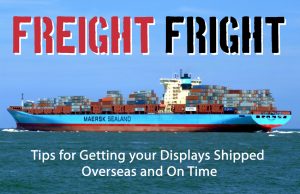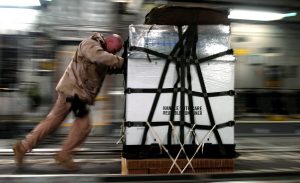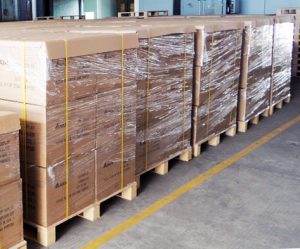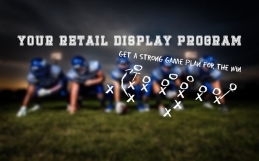 NAVIGATING THE WATERS OF OVERSEAS SHIPPING
NAVIGATING THE WATERS OF OVERSEAS SHIPPING
A lot of details are involved in arranging the overseas shipping of your display order. One missing detail can delay your shipment by a day simply because of the considerable difference in time zones. Although severe weather and accidents are beyond our control, there are a number of things that can be done to ensure a faster shipment process. Here are several tips that will help you get your displays shipped overseas and on time:
SUBMIT A DETAILED PURCHASE ORDER
A purchase order is a legal contract between the supplier and the seller that, at the very least, states the ordered item’s description, the agreed upon price and the quantity ordered. When the buyer submits a purchase order to a supplier, they enter into a legally binding contract. Without this document, the seller is left unprotected should problems arise regarding the order. Problems can include anything from a disagreement in pricing to what quantities define a selling unit to how and where the displays should have shipped and so on. Any number of misinterpretations can be made when a verbal agreement or even an agreement made over a string of emails takes the place of a clearly written purchase order. Additional delays happen when important details are left out such as a purchase order number, ship-to address, shipping method (Ocean or Air), shipping terms and a freight forwarder.
PROVIDE A PURCHASE ORDER (PO) NUMBER
Your order will be in the hands of many parties within the supply chain, including the manufacturer, customs and the various carriers contracted by the freight forwarder to get your product from factory to port of loading to sea or air to port of discharge and then shipped to the final destination. These parties are handling many other orders in addition to yours. Having a Purchase Order number will allow multiple parties to easily identify your order. Freight forwarders have been known to delay the shipment process because of the lack of an official Purchase Order number or confusion regarding mismatched Purchase Order numbers from the client and the supplier.
STATE YOUR INCOTERMS
Incoterms or International Commercial Terms are pre-set shipping terms that clearly define which parties pay for and assume the risk of your cargo at different points throughout the shipment process. A couple of examples of incoterms include FOB and EXW. FOB or Free on Board means that the buyer is the responsible party as soon as the cargo crosses the vessel’s railing. EXW, also known as Ex-Works or Ex-Factory, means that the buyer is responsible for the cargo from loading at origin all the way to destination delivery. Decide on and make your incoterms known so there is no confusion when your cargo is ready to ship overseas.
HAVE A PREFERRED FREIGHT FORWARDER
A freight forwarder acts as your agent, arranges your cargo for ocean or air and files export documentation for you. There are many benefits to building a relationship with a freight forwarder:
- You can easily request the cheapest overseas shipping rates or quickest transit possible based on your needs.
- You are not contractually obligated to stick with one freight forwarder which means they’ll work harder to keep your business.
- This one-stop shop will take care of insurance, customs clearing and carriers.
- Import regulations for each country are constantly changing. Your freight forwarder can ensure that your shipment is always in compliance.
- You have one point of contact managing your cargo, which means less confusion and easy tracking.
- Last but not least, knowing what freight forwarder you’ll be shipping with ahead of time allows us to begin the shipment process more quickly. www.forwarder.com is an international freight forwarder directory that allows you to search and get quotes from multiple freight forwarders.
 PROVIDE A DISPLAY-SPECIFIC SHIPPING GUIDE
PROVIDE A DISPLAY-SPECIFIC SHIPPING GUIDE
On occasion, our clients will provide us with a shipping guide for product instead of displays. Time is wasted sifting through the manual to figure out what requirements pertain to product versus displays. Supplying a display-specific shipping guide as an addendum to your purchase order creates a map that we can confidently refer to. No time is lost chasing answers to book your order for shipment with the freight forwarder.
A shipping guide should ideally include – for each specific city destination – the company name, contact name, email address and phone numbers for the following:
• Freight Forwarder
• Consignee Address: The party that is financially responsible for the shipment
• Ship-To Address: The final destination
• Two Notify Parties: The contacts that need to know when the cargo arrives at the port (Having two notify parties is ideal in case one cannot be reached.)
Providing the following is also helpful:
• Port of Discharge: At what city port would you like your cargo unloaded?
• How should the Bill of Lading (B/L) be issued – Original, Telex Release or Express? The shipper usually decides this since this document is a form of payment protection that entitles them to decide when the cargo can be released. However, if importers ask for a faster method, usually a Telex Release, the shipper in most cases allows it. In the case of air freight shipments, the shipper will encourage a Telex Release over an Original Bill of Lading so the cargo does not arrive ahead of the document. Therefore, it doesn’t hurt to provide this information.
Here’s a short explanation of the 3 types of Bill of Ladings available:
With an Original Bill of Lading, the shipper usually holds onto the Original until they have received payment. Upon payment, the shipper sends it via courier to the importer so it can be shown as proof of payment to release the cargo.
In the case of a Telex Release, when cargo is ready for release, the shipper sends the Original Bill of Lading back to the shipping company and the origin branch of the shipping company notifies the destination branch that the cargo can be released.
If the shipper decides on an Express Release, no Original Bill of Lading is manifested and the cargo is released immediately.
PROVIDE IDENTIFYING MARKS FOR YOUR CARTONS
There are several benefits to having your boxed displays marked with identifying information. If your cartons ship loose (non-palletized), having identifying marks will ensure that the cargo stays together. It also helps your receiving staff to immediately identify what is in the carton and process it in the company records that it has been received. If the carton is being re-shipped from your warehouse to stores, it helps the shippers ensure that they are shipping the correct display. Below are the markings that we usually include on the carton. The earlier you can provide this information, the better the chances of staying on schedule:
• Your company’s description of each display selling unit*
• SKU number*
• PO number*
• UPC number* or barcode, if applicable
• Country of Origin: This information depends on the manufacturer’s location.
* This information should be on the official Purchase Order that you provided early on.
As you can see, there are a lot of details that need attention when shipping overseas cargo. Providing complete information ahead of time can increase the odds that your shipment will arrive in time for your deadline.


